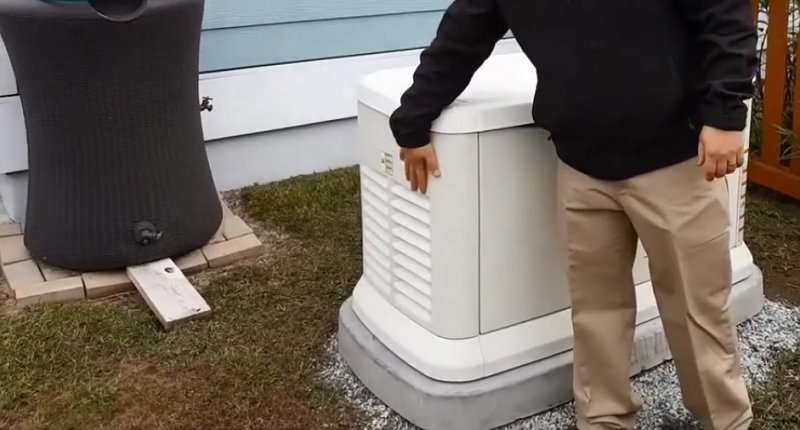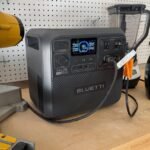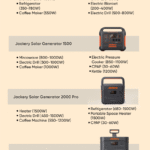Disclosure: This post contains affiliate links and I will be compensated if you make a purchase after clicking through my links. Learn More
The exhaust on a Generac generator is typically located on the side or back of the unit. It directs fumes away from the generator.
Generac generators are a popular choice for backup power solutions. Knowing the location of the exhaust is crucial for safe and efficient operation. Proper exhaust placement ensures harmful fumes are directed away from living spaces. This reduces the risk of carbon monoxide poisoning.
Always check the user manual for exact exhaust location and safety guidelines. Regular maintenance and checks can extend the generator’s life. Proper ventilation around the exhaust area is essential. Keeping the exhaust area clear of obstructions ensures optimal performance. Follow these tips to maintain your Generac generator safely and effectively.

Basics Of Generac Generators
Generac generators are a popular choice for backup power. They offer reliability and efficiency during power outages. Understanding where the exhaust is on a Generac generator starts with knowing the basics.
Types Of Generac Generators
Generac offers various types of generators. Each type serves different needs:
- Portable Generators: These are easy to move and perfect for small power needs.
- Home Standby Generators: These automatically supply power to your home during outages.
- Commercial Generators: These provide power for businesses and large facilities.
Common Features
Generac generators share several common features that ensure smooth operation:
| Feature | Description |
|---|---|
| Automatic Transfer Switch (ATS) | Switches power source automatically during an outage. |
| Quiet-Test Mode | Runs weekly self-tests quietly. |
| Weather-Resistant Enclosure | Protects the generator from harsh weather conditions. |
Knowing these features helps you understand the design and functionality of your generator.
Locating The Exhaust
Finding the exhaust on a Generac generator is important for safety. Correct placement prevents exhaust buildup and keeps everyone safe. Below are details on exhaust locations for different types of Generac generators.
Exhaust Placement In Portable Generators
Portable Generac generators are designed for mobility. The exhaust is usually found on the side or back. This location helps to direct fumes away from users. Look for a small, metal pipe sticking out. This is the exhaust outlet.
Portable generators often have labels near the exhaust. These labels warn of hot surfaces and fumes. Always check these labels before operating the generator. Ensure the exhaust is clear of obstructions.
Exhaust Placement In Standby Generators
Standby Generac generators are larger and permanently installed. The exhaust is typically on the top or side. This placement allows for better ventilation. Standby generators often have a more complex exhaust system.
These systems include mufflers and heat shields. These components reduce noise and heat. Look for a metal pipe extending from the unit. This pipe is the main exhaust outlet. Ensure nothing blocks this exhaust path.
Exhaust System Components
The exhaust system of a Generac generator is essential for safe operation. It removes harmful gases from the engine. The main components include the muffler and the exhaust pipe. These parts ensure that the generator runs smoothly and quietly.
Muffler
The muffler is a key part of the exhaust system. It reduces noise from the engine. Inside the muffler, there are chambers and baffles. These parts help to muffle the sound. The muffler also directs exhaust gases away from the engine.
Mufflers are usually made of steel. They are designed to withstand high temperatures. A good muffler keeps the generator quiet. This is important for both comfort and safety.
Exhaust Pipe
The exhaust pipe connects to the muffler. It carries exhaust gases away from the generator. The pipe is usually made of durable metal. This helps it handle the hot gases.
Exhaust pipes come in different lengths. The length depends on the generator model. A longer pipe directs exhaust further away. This reduces the risk of inhaling harmful fumes.
Maintaining the exhaust pipe is crucial. Check for cracks or leaks regularly. A damaged pipe can be dangerous. Always replace faulty exhaust pipes immediately.
| Component | Function | Material |
|---|---|---|
| Muffler | Reduces noise, directs gases | Steel |
| Exhaust Pipe | Transports gases away | Durable metal |

Safety Precautions
Ensuring safety when using a Generac generator is crucial. This section covers essential precautions, focusing on proper ventilation and avoiding carbon monoxide poisoning.
Proper Ventilation
Generators need good airflow. Lack of ventilation can lead to overheating. Here are some tips:
- Place the generator outdoors in a well-ventilated area.
- Keep it away from windows and doors.
- Avoid enclosed spaces like garages or basements.
Make sure the exhaust points away from living spaces. This reduces the risk of fumes entering your home.
Avoiding Carbon Monoxide Poisoning
Carbon monoxide (CO) is a deadly gas. It’s colorless, odorless, and hard to detect. Follow these steps to stay safe:
- Install carbon monoxide detectors in your home.
- Check the detectors regularly to ensure they work.
- Never run the generator indoors or in partially enclosed areas.
Always position the generator so the exhaust points away from people. This simple step can save lives.
| Safety Tip | Action |
|---|---|
| Proper Ventilation | Keep the generator outdoors in open spaces. |
| Carbon Monoxide Detection | Install and maintain CO detectors in your home. |
Maintenance Tips
Regular maintenance of your Generac generator ensures its long life and efficiency. The exhaust system is crucial for safe operation. Follow these maintenance tips to keep your generator in top shape.
Regular Inspections
Inspect the exhaust system every month. Look for cracks, holes, and rust. Check the mounting brackets for tightness. A loose exhaust can lead to noise and danger. Use a flashlight to check inside the exhaust pipe. Ensure there is no blockage. A clogged exhaust can cause the generator to overheat.
Here is a simple checklist for your inspections:
- Check for visible damage.
- Ensure tightness of mounting brackets.
- Look inside the exhaust pipe for blockages.
Cleaning The Exhaust
Cleaning the exhaust is essential for proper function. Use a wire brush to remove rust. Clean the outside of the exhaust pipe. Remove any debris around the exhaust area. A clean exhaust ensures safe operation.
Follow these steps to clean the exhaust:
- Turn off the generator and let it cool.
- Use a wire brush to clean the exhaust pipe.
- Wipe down the exhaust with a damp cloth.
Keeping the exhaust system clean and inspected will ensure your Generac generator runs smoothly. Regular checks and cleanings are simple but vital for safety and performance.
Troubleshooting Exhaust Issues
Exhaust issues in a Generac Generator can be frustrating. Identifying the root cause is essential for a smooth operation. This section will guide you through common problems and when to call a professional.
Common Problems
Generators can face several exhaust issues. Here are some common problems:
- Clogged Exhaust: Debris and soot can block the exhaust.
- Leaks: Gaskets or seals might be worn out.
- Excessive Noise: This could indicate a problem with the muffler.
- Overheating: Poor ventilation can lead to overheating.
When To Call A Professional
Sometimes, exhaust issues need expert attention. Call a professional when:
- There’s a persistent smell of gas.
- The exhaust system is visibly damaged.
- You notice strange noises that won’t go away.
- The generator overheats despite cleaning and maintenance.
Frequently Asked Questions
Where Is The Exhaust Located On A Generac Generator?
The exhaust is typically on the side or rear of the generator.
Why Is The Exhaust Location Important?
The location ensures proper ventilation and prevents harmful fumes from accumulating.
How Do I Identify The Exhaust Port?
Look for a metal pipe or muffler extending from the generator’s body.
Can I Relocate The Exhaust On My Generator?
It’s not recommended to relocate the exhaust as it can affect performance and safety.
Final Words
Locating the exhaust on a Generac generator is essential for safe operation. It ensures proper ventilation and performance. Always refer to the user manual for exact details. Regular maintenance can prevent harmful emissions. Understanding your generator’s layout can extend its lifespan and ensure your safety.
Stay informed and keep your generator running smoothly.








